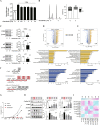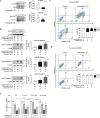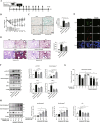Nintedanib induces senolytic effect via STAT3 inhibition
- PMID: 36055997
- PMCID: PMC9440251
- DOI: 10.1038/s41419-022-05207-8
Nintedanib induces senolytic effect via STAT3 inhibition
Abstract
Selective removal of senescent cells, or senolytic therapy, has been proposed to be a potent strategy for overcoming age-related diseases and even for reversing aging. We found that nintedanib, a tyrosine kinase inhibitor, selectively induced the death of primary human dermal fibroblasts undergoing RS. Similar to ABT263, a well-known senolytic agent, nintedanib triggered intrinsic apoptosis in senescent cells. Additionally, at the concentration producing the senolytic effect, nintedanib arrested the cell cycle of nonsenescent cells in the G1 phase without inducing cytotoxicity. Interestingly, the mechanism by which nintedanib activated caspase-9 in the intrinsic apoptotic pathway differed from that of ABT263 apoptosis induction; specifically, nintedanib did not decrease the levels of Bcl-2 family proteins in senescent cells. Moreover, nintedanib suppressed the activation of the JAK2/STAT3 pathway, which caused the drug-induced death of senescent cells. STAT3 knockdown in senescent cells induced caspase activation. Moreover, nintedanib reduced the number of senescence-associated β-galactosidase-positive senescent cells in parallel with a reduction in STAT3 phosphorylation and ameliorated collagen deposition in a mouse model of bleomycin-induced lung fibrosis. Consistently, nintedanib exhibited a senolytic effect through bleomycin-induced senescence of human pulmonary fibroblasts. Overall, we found that nintedanib can be used as a new senolytic agent and that inhibiting STAT3 may be an approach for inducing the selective death of senescent cells. Our findings pave the way for expanding the senolytic toolkit for use in various aging statuses and age-related diseases.
© 2022. The Author(s).
Conflict of interest statement
The authors declare no competing interests.
Figures






References
Publication types
MeSH terms
Substances
LinkOut - more resources
Full Text Sources
Other Literature Sources
Molecular Biology Databases
Miscellaneous

